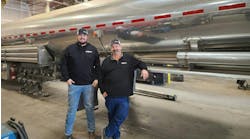Corrosion is a significant and expensive problem for commercial vehicles. Based on a recent estimate from the Federal Highway Administration report, corrosion costs U.S. businesses an estimated $500 Billion each year, or up to 6% of the nation’s GDP.
NACE, the Houston-based international organization focused on developing corrosion prevention and control standards, attributes more than 20% of that cost to the transportation and infrastructure industries. This raises three important questions: (1) what is the root cause of this problem, (2) what is the science behind corrosion, and (3) what strategies and technology can help reduce and control corrosion?
Cause of corrosion
Road debris, sand, gravel and, especially, deicing materials will sandblast vehicle underbodies. This leaves chips in the coating meaning that the underlying substrate is exposed to a corrosive environment. Moisture, severe temperatures and corrosive chemicals further contribute to breakdown of the underlying substrate. Areas that are typically effected by ice melting chemicals and rock impingement include: rear frames, gussets, rear under ride guards, threshold plates, front aprons, upper couplers, landing gear brackets and braces, front under structure, suspension and axle assy, and main frame assy.
Science of corrosion
The chemical makeup of rust corrosion takes place as an electrochemical cell in which iron (Fe) serves as the anode, oxygen gas as the cathode, and the aqueous solution of ions serving as an electrolyte. The presence of salt greatly enhances the rusting of metals. This is because the dissolved salt increases the conductivity of the aqueous solution formed at the surface of the metal and enhances the rate of electrochemical corrosion. For more than 50 years, sodium chloride (rock salt) has been used for de-icing roadways. In fact, in 2014, highway deicing consumed 43% of total salt usage in the United States, amounting to almost 20,000 tons.
Magnesium chloride and calcium chloride are more efficient deicing alternatives due to ease and speed of application as well as being effective at low temperatures. But these are especially destructive because they cling to the underbody of a vehicle and crystallize as they slowly dry out. These crystals are hydrophilic and absorb moisture, keeping them in a semi-solution state for extended periods of time which multiplies their corrosiveness.
All salts (chlorides) used for deicing are corrosive, but deicing is a necessity. Snow- and ice-related highway and business closures and accidents represent a significant cost. Deicing reduces closures, crashes, injuries and these accident related costs by 85%. So how can we address corrosion in a way that makes financial sense for companies?
The most obvious solution is to re-design the vulnerable parts of commercial vehicles with corrosion resistant materials and/or provide an effective barrier to block moisture, salt and oxygen from reacting with the steel surface. Solutions to consider include soft film barriers, galvanized parts, aluminum parts and stainless steel parts.
Soft film barrier as a solution
The most common soft film barriers consist of Thixotropic oil or grease based films, and corrosion inhibitive pigments. These are generally soft and highly surfactant coatings that have a greater affinity to the substrate than to itself. This allows “self-healing” and moderate creep back of damaged areas. Additional advantages of soft film barriers include relatively low cost, remains soft and flexible, and they are effective at reducing corrosion. Disadvantages are that the barrier remains somewhat sticky which attracts dirt and can be damaged by stone impingement. These soft barriers are typically used in sheltered or moderate environments to ward off corrosion and water and would not stand up to the harsh environments encountered in transportation.
Galvanized steel or other metals
Another option is to galvanize or replace steel with other metals. Galvanization applies a protective zinc coating to protect metals from rusting. The zinc prevents corrosive substances from reaching the underlying metal and when scratched serves as an anode for the exposed metal surface.
Galvanized aluminum and stainless steel are very effective in the fight against corrosion. However, galvanized metal is still subject to corrosion in high salt and cold conditions. In addition, increased cost of using them can become a competitive disadvantage in both manufacturing and replacing damaged parts.
Another concern is galvanic corrosion, which happens when dissimilar metals come into contact with each other. Indeed, manufacturers and collision repair shops must give serious consideration to potential cross-contamination and make every effort to prevent it. They must provide separate areas where only aluminum is repaired, away from steel vehicles where grinding, sanding, welding or other intensive repairs are taking place.
They must also consider a separate set of metal working tools used exclusively for aluminum, clean all hammers, dollies, cutting tools, pry bars etc., before and after using on aluminum. Even when clamps are used, they need to clean jaws thoroughly before and after use on aluminum.
Protective polyurea and polyurethane coatings
A protective coating can offer a feasible and long-term solution for corrosion control, without the issues inherent in soft film barriers and galvanizing methods. Epoxy-based and polyurethane, polyurea and hybrid coatings have been widely used in metal application. Epoxies are well known for their excellent adhesion to metal and chemical resistance. However, epoxies have low flexibility, low impact resistance and tend to become brittle in cold temperatures. In the transportation industry, this would become a problem with rock and salt impingement.
Polyureas and polyurethanes, however, offer unrivaled durability and chemical resistance in even the most extreme weather. They are also very flexible and impact resistant and will not cut, peel, crack or chip. When these coatings are applied to underbodies they resemble spray-on truck bed liner material but have unique properties.
Polyurea and polyurethane coatings can be developed specifically for corrosion underbody protection from rock and stone impingement, extreme weather conditions, and chemical resistance to de-icing chemicals (sodium chloride, magnesium chloride, and calcium chloride).
In essence, corrosion is a chemical or electrochemical reaction between a material and its environment that produces deterioration of the material or its properties. By understanding what creates corrosion and rust, the transportation and infrastructure industries can predict where it will occur and learn the best ways to prevent it, thus reducing direct and indirect costs to businesses.
The good news is that while corrosion is costly, it doesn’t have to be. In addition, to regular maintenance, polyurethane and polyurea coatings represent a gold standard in corrosion protection. Many companies are adopting polyurethane and polyurea coatings because they can withstand the harshest environments for a longer period of time. To that end, these companies are able to save time in repairing damaged parts and extend the life of the equipment.
(Alan Cain is the Group Leader/Research Chemist at Chemline Inc.)










